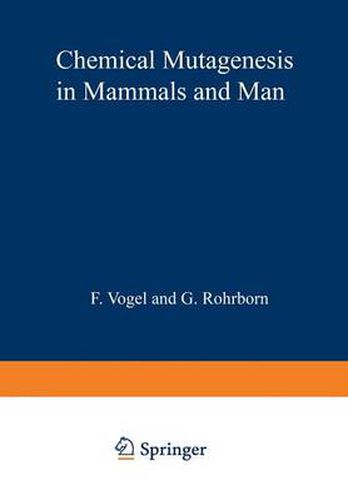Readings Newsletter
Become a Readings Member to make your shopping experience even easier.
Sign in or sign up for free!
You’re not far away from qualifying for FREE standard shipping within Australia
You’ve qualified for FREE standard shipping within Australia
The cart is loading…






This title is printed to order. This book may have been self-published. If so, we cannot guarantee the quality of the content. In the main most books will have gone through the editing process however some may not. We therefore suggest that you be aware of this before ordering this book. If in doubt check either the author or publisher’s details as we are unable to accept any returns unless they are faulty. Please contact us if you have any questions.
Encouraged by the results with radiation genetics, the editors of this volume have tried since 1963 to organize a team of scientists in Heidelberg who would examine the problem of chemical mutagenesis in mammals with a variety of methods. Meanwhile, other organizations have also become interested in this problem and various teams, particularly in the U.S.A., but also in West Germany, are working in this field. This development is very auspicious; the spectrum of our methods does permit limited conclusions as to the mutagenic effects of chemical substances in mammals, but we are still far away from a thorough determination of all the genetically relevant effects. New methods must be developed. This volume is the result of a request by the Chairman of the Gesellschaft fUr Anthropologie und Humangenetik , Frau Professor Dr. I. SCHWIDETZKY (Mainz), that one of us (F.V.) organize a symposium concerning mutation research in the framework of its annual meeting on October 7, 1969. The most sensible approach seemed to be one of centering the discussion on the test methods employed in mutagenicity research with mammals. With the aid of the Deutsche Forschungsgemeinschaft and the pharma- ceutical industry it was possible to invite scientists from the U.S.A. We wish to thank Firma Thomae, Biberach, Firma Bayer, Leverkusen, and Firma Boehringer, Mannheim, for their contributions. We wish to thank Dr. HAsso SCHROEDER especially for his efforts on our behalf.
$9.00 standard shipping within Australia
FREE standard shipping within Australia for orders over $100.00
Express & International shipping calculated at checkout
This title is printed to order. This book may have been self-published. If so, we cannot guarantee the quality of the content. In the main most books will have gone through the editing process however some may not. We therefore suggest that you be aware of this before ordering this book. If in doubt check either the author or publisher’s details as we are unable to accept any returns unless they are faulty. Please contact us if you have any questions.
Encouraged by the results with radiation genetics, the editors of this volume have tried since 1963 to organize a team of scientists in Heidelberg who would examine the problem of chemical mutagenesis in mammals with a variety of methods. Meanwhile, other organizations have also become interested in this problem and various teams, particularly in the U.S.A., but also in West Germany, are working in this field. This development is very auspicious; the spectrum of our methods does permit limited conclusions as to the mutagenic effects of chemical substances in mammals, but we are still far away from a thorough determination of all the genetically relevant effects. New methods must be developed. This volume is the result of a request by the Chairman of the Gesellschaft fUr Anthropologie und Humangenetik , Frau Professor Dr. I. SCHWIDETZKY (Mainz), that one of us (F.V.) organize a symposium concerning mutation research in the framework of its annual meeting on October 7, 1969. The most sensible approach seemed to be one of centering the discussion on the test methods employed in mutagenicity research with mammals. With the aid of the Deutsche Forschungsgemeinschaft and the pharma- ceutical industry it was possible to invite scientists from the U.S.A. We wish to thank Firma Thomae, Biberach, Firma Bayer, Leverkusen, and Firma Boehringer, Mannheim, for their contributions. We wish to thank Dr. HAsso SCHROEDER especially for his efforts on our behalf.